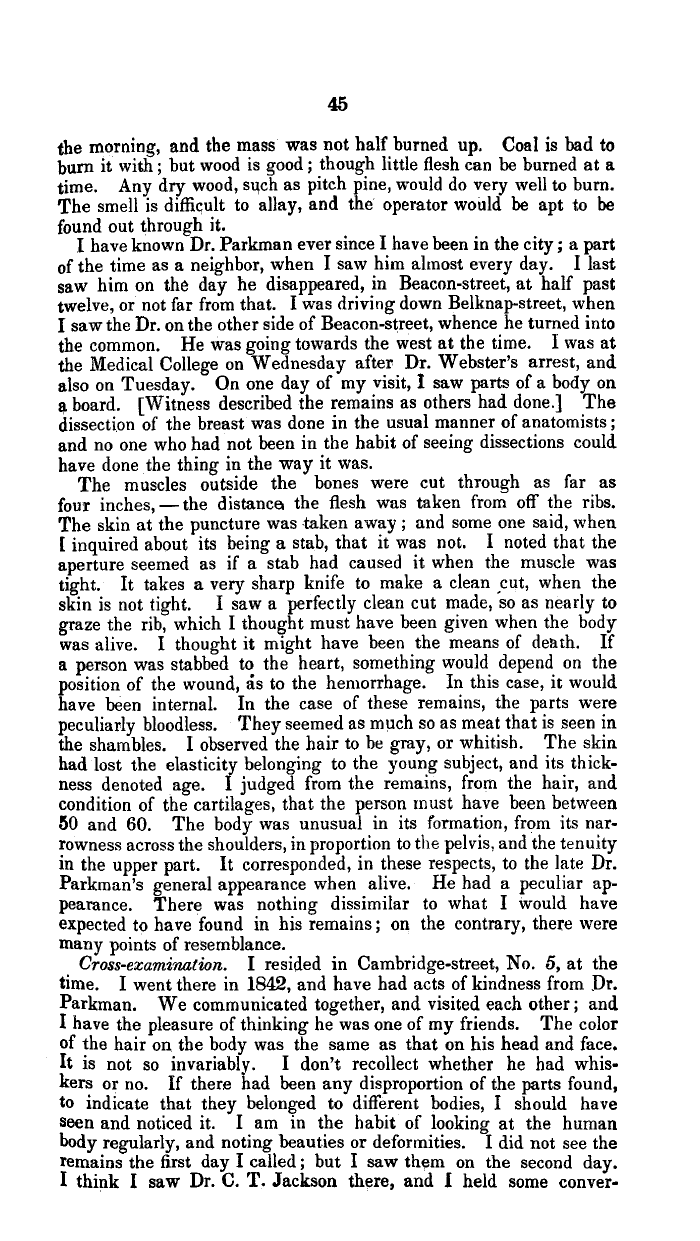|
45
the morning, and the mass was not half burned up. Coal is bad to
burn it with; but wood is good; though little flesh can be burned at a
time. Any dry wood, such as pitch pine, would do very well to burn.
The smell is difficult to allay, and the operator would be apt to be
found out through it.
I have known Dr. Parkman ever since I have been in the city; a part
of the time as a neighbor, when I saw him almost every day. I last
saw him on the day he disappeared, in Beacon-street, at half past
twelve, or not far from that. I was driving down Belknap-street, when
I saw the Dr. on the other side of Beacon-street, whence he turned into
the common. He was going towards the west at the time. I was at
the Medical College on Wednesday after Dr. Webster's arrest, and
also on Tuesday. On one day of my visit, I saw parts of a body on
board. [Witness described the remains as others had done.] The
dissection of the breast was done in the usual manner of anatomists;
and no one who had not been in the habit of seeing dissections could
have done the thing in the way it was.
The muscles outside the bones were cut through as far as
four inches,-the distance the flesh was taken from off the ribs.
The skin at the puncture was taken away; and some one said, when
f inquired about its being a stab, that it was not. I noted that the
aperture seemed as if a stab had caused it when the muscle was
tight. It takes a very sharp knife to make a clean cut, when the
skin is not tight. I saw a perfectly clean cut made, so as nearly to
graze the rib, which I thought must have been given when the body
was alive. I thought it might have been the means of death. If
a person was stabbed to the heart, something would depend on the
position of the wound, as to the hemorrhage. In this case, it would
have been internal. In the case of these remains, the parts were
peculiarly bloodless. They seemed as much so as meat that is seen in
the shambles. I observed the hair to be gray, or whitish. The skin
had lost the elasticity belonging to the young subject, and its thick-
ness denoted age. I judged from the remains, from the hair, and
condition of the cartilages, that the person must have been between
50 and 60. The body was unusual in its formation, from its nar-
rowness across the shoulders, in proportion to the pelvis, and the tenuity
in the upper part. It corresponded, in these respects, to the late Dr.
Parkman's general appearance when alive. He had a peculiar ap-
pearance. There was nothing dissimilar to what I would have
expected to have found in his remains; on the contrary, there were
many points of resemblance.
Cross-examination. I resided in Cambridge-street, No. 5, at the
time. I went there in 1842, and have had acts of kindness from Dr.
Parkman. We communicated together, and visited each other; and
I have the pleasure of thinking he was one of my friends. The color
of the hair on the body was the same as that on his head and face.
It is not so invariably. I don't recollect whether he had whis.
kers or no. If there had been any disproportion of the parts found,
to indicate that they belonged to different bodies, I should have
seen and noticed it. I am in the habit of looking at the human
body regularly, and noting beauties or deformities. I did not see the
remains the first day I called; but I saw them on the second day.
I think I saw Dr. C. T. Jackson there, and I held some conver-
|

